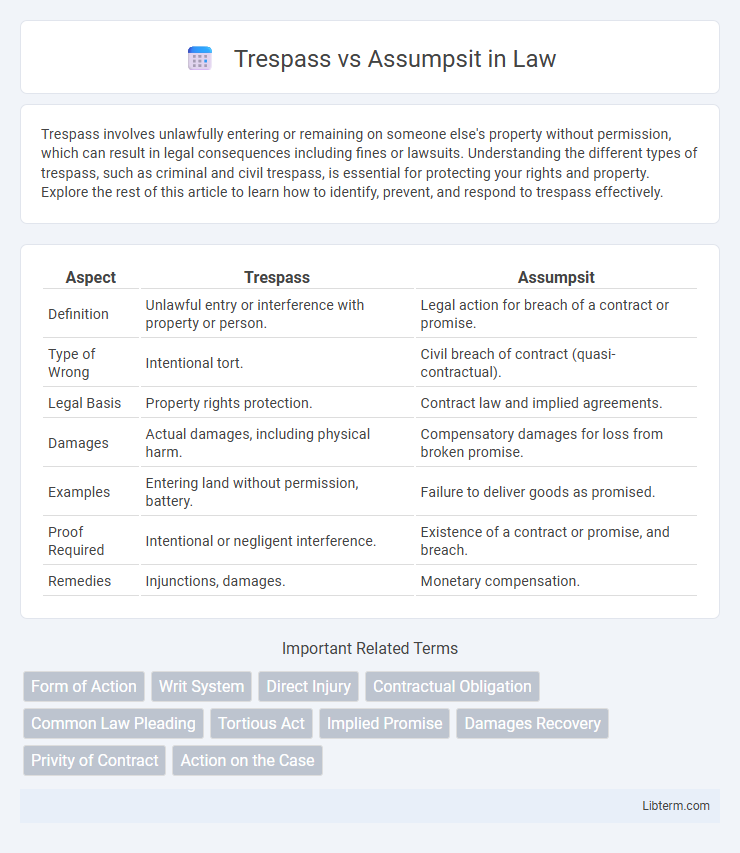Trespass involves unlawfully entering or remaining on someone else's property without permission, which can result in legal consequences including fines or lawsuits. Understanding the different types of trespass, such as criminal and civil trespass, is essential for protecting your rights and property. Explore the rest of this article to learn how to identify, prevent, and respond to trespass effectively.
Table of Comparison
| Aspect | Trespass | Assumpsit |
|---|---|---|
| Definition | Unlawful entry or interference with property or person. | Legal action for breach of a contract or promise. |
| Type of Wrong | Intentional tort. | Civil breach of contract (quasi-contractual). |
| Legal Basis | Property rights protection. | Contract law and implied agreements. |
| Damages | Actual damages, including physical harm. | Compensatory damages for loss from broken promise. |
| Examples | Entering land without permission, battery. | Failure to deliver goods as promised. |
| Proof Required | Intentional or negligent interference. | Existence of a contract or promise, and breach. |
| Remedies | Injunctions, damages. | Monetary compensation. |
Introduction to Trespass and Assumpsit
Trespass involves a direct and unlawful interference with a person, property, or possession, establishing liability through intentional or negligent acts causing harm. Assumpsit arises from a breach of an implied or explicit promise, typically concerning contractual obligations or restitution claims. Both tort and contract principles intersect in these actions, defining the basis for damages and legal remedies.
Historical Origins of Trespass
Trespass originated in English common law as a remedy for direct and forcible injuries to person or property, focusing on physical interference or harm. Rooted in medieval legal systems, trespass initially addressed breaches of the peace and personal wrongs, evolving from early writs that required immediate physical injury. This historical foundation distinguishes trespass from assumpsit, which arose later to cover breaches of contract and non-physical wrongs.
Evolution and Significance of Assumpsit
Assumpsit evolved in English common law as a flexible legal remedy addressing breaches of informal promises not covered by writs of trespass. This development allowed plaintiffs to seek damages for non-violent contractual breaches or failures in performance, thus expanding judicial protection beyond physical injuries or property damage. Assumpsit's significance lies in its role as a precursor to modern contract law, shifting focus towards enforceability of agreements and fostering commercial reliability.
Key Legal Principles: Trespass
Trespass involves the direct and intentional interference with a person's possession of land or chattels, establishing liability through physical intrusion or harm without lawful justification. The key legal principle in trespass emphasizes strict liability, meaning intent to trespass is not necessary--only the unlawful entry or interference must be proven. Remedies typically include damages for actual harm caused, emphasizing protection of possession rather than ownership rights.
Key Legal Principles: Assumpsit
Assumpsit is a common law action based on a breach of a simple or implied contract, requiring proof of a promise, consideration, and breach. It focuses on enforcing contractual obligations where one party fails to fulfill their agreed duty, emphasizing the intent to create legal relations. The principle distinguishes from trespass by centering on consensual agreements rather than wrongful interference with person or property.
Differences in Causes of Action
Trespass involves direct, immediate harm or injury to a person's property or body, characterized by intentional or negligent acts such as unlawful entry or physical damage. Assumpsit is a common law cause of action based on breach of a contractual or quasi-contractual agreement, requiring proof of a promise, reliance, and failure to perform. The key difference lies in trespass addressing wrongful physical acts causing harm, while assumpsit centers on enforcement of non-performance of obligations within agreements.
Examples of Trespass in Modern Law
Trespass in modern law commonly includes unauthorized entry onto private property, such as entering a fenced backyard without permission, or physically damaging another person's belongings, like breaking a car window. Walking on private land despite posted "No Trespassing" signs exemplifies direct interference with possession. Physical invasions that cause harm, including throwing objects onto someone's property, also constitute actionable trespass.
Examples of Assumpsit in Modern Law
Examples of assumpsit in modern law include breach of contract cases where one party fails to fulfill promises explicitly stated in agreements, such as unpaid services or undelivered goods. Assumpsit claims often arise in employment disputes when wages are withheld despite work completion or in loan agreements where repayment terms are ignored. Courts typically enforce assumpsit through damages awarded for losses directly resulting from the broken promise, distinguishing it from trespass which involves unlawful physical interference.
Comparative Analysis: Trespass vs Assumpsit
Trespass involves direct and immediate injury or injury caused by a definite act, focusing on unlawful physical interference or damage to person or property, while assumpsit addresses breach of a contract or agreement, dealing primarily with non-performance or failure to fulfill a promise. The key distinction lies in trespass's emphasis on tortious acts demanding proof of actual harm, whereas assumpsit centers on contractual obligations requiring proof of agreement and breach. Courts evaluate trespass claims under tort law principles emphasizing wrongful acts, whereas assumpsit cases are adjudicated under contract law emphasizing enforceable promises.
Implications for Legal Practice Today
The distinction between trespass and assumpsit continues to influence legal practice by shaping the framework for actionable claims in tort and contract law; trespass addresses direct interference with property or person, while assumpsit pertains to breaches of implied or explicit promises. Modern courts often rely on this differentiation to determine appropriate remedies and procedural approaches, ensuring precise allocation of liability and compensation. Understanding these historical roots facilitates accurate case strategy, risk assessment, and client advisement in contemporary civil litigation.
Trespass Infographic

 libterm.com
libterm.com